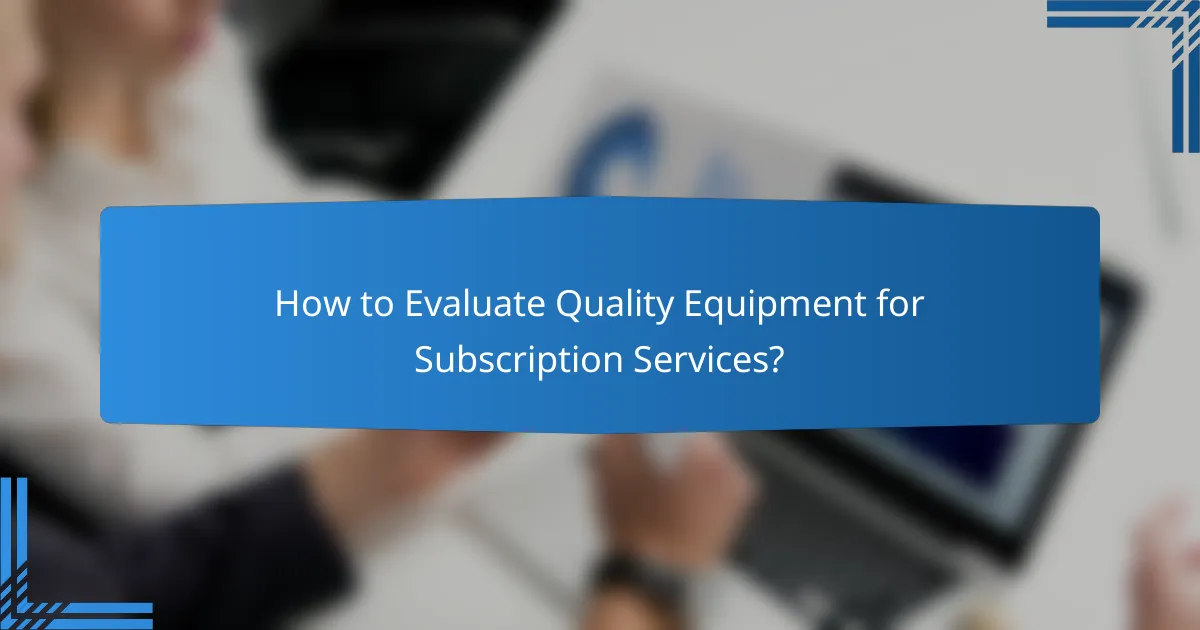Investing in quality equipment brings a multitude of benefits, including improved efficiency, safety, and performance. High-grade tools and machinery not only enhance user experience but also ensure longevity, reducing the likelihood of breakdowns and the need for frequent replacements. Ultimately, choosing quality gear translates to significant long-term savings and reliable performance, making it a smart decision for any user.

What Are the Benefits of Quality Equipment?
Quality equipment offers numerous advantages, including enhanced efficiency, safety, and performance. Investing in high-grade tools and machinery can lead to significant long-term savings and a better overall user experience.
Increased efficiency
Quality equipment is designed to operate at optimal levels, reducing downtime and increasing productivity. For example, a high-performance machine can complete tasks faster and with less energy consumption compared to lower-quality alternatives.
When selecting equipment, consider its specifications and user reviews to ensure it meets your efficiency needs. Investing in reliable tools can streamline operations and minimize delays.
Enhanced safety
Using quality equipment significantly reduces the risk of accidents and injuries in the workplace. High-quality tools often come with better safety features and adhere to strict industry standards, ensuring safer operation.
Always check for safety certifications and user feedback when purchasing equipment. This proactive approach can help you avoid potential hazards and ensure a safer working environment.
Improved performance
Quality equipment typically delivers superior performance, allowing users to achieve better results. For instance, precision tools can enhance accuracy in tasks, leading to higher-quality outputs.
When evaluating equipment, look for features that contribute to performance, such as durability and ease of use. Investing in well-reviewed products can lead to noticeable improvements in your work quality.
Long-term cost savings
Although quality equipment may require a higher initial investment, it often results in lower long-term costs. Durable tools tend to have longer lifespans and require fewer repairs, which can save money over time.
Consider the total cost of ownership when purchasing equipment, including maintenance and replacement costs. Opting for quality can lead to significant savings in the long run.
Better user experience
Quality equipment enhances the user experience by providing greater comfort and ease of use. Ergonomically designed tools can reduce strain and fatigue, making tasks more enjoyable and efficient.
When selecting equipment, prioritize user-friendly features and comfort. A positive user experience can lead to increased satisfaction and productivity in the workplace.

How Does Quality Equipment Impact Longevity?
Quality equipment significantly enhances longevity by ensuring that tools and machinery are built to withstand wear and tear over time. Investing in high-quality items typically results in fewer breakdowns and a more reliable performance throughout their use.
Durability and reliability
Durability refers to the ability of equipment to resist damage and maintain functionality under stress. Reliable equipment is less likely to fail unexpectedly, which is crucial for both safety and productivity. For example, industrial machinery made from high-grade materials can endure harsh conditions, reducing the risk of operational downtime.
When selecting equipment, look for products that meet industry standards for durability. Certifications such as ISO or ANSI can indicate a commitment to quality, ensuring that the equipment will perform reliably over its intended lifespan.
Reduced maintenance needs
Quality equipment often requires less maintenance compared to lower-grade alternatives. This reduction in maintenance needs can save time and money, allowing resources to be allocated elsewhere. For instance, a well-made lawn mower may only need an oil change once a season, while a cheaper model might require frequent repairs.
To maximize efficiency, consider investing in equipment that comes with warranties or service plans. These options can provide peace of mind and further reduce unexpected maintenance costs.
Extended lifespan
The lifespan of quality equipment tends to be significantly longer than that of inferior products. High-quality materials and construction techniques contribute to this extended lifespan, meaning that users can expect to get many years of service from their investment. For example, a premium power tool can last a decade or more with proper care, while a budget option may only function well for a few years.
To ensure longevity, follow the manufacturer’s guidelines for use and care. Regular inspections and proper storage can also help maintain equipment in optimal condition, extending its useful life even further.

What Is the Value of Investing in Quality Equipment?
Investing in quality equipment provides significant long-term benefits, including durability, efficiency, and overall cost savings. Quality gear often leads to better performance and reliability, making it a wise choice for both personal and professional use.
Higher resale value
Quality equipment typically retains its value better than lower-grade alternatives. When you invest in well-made tools or machinery, they often have a higher resale price, which can recoup a significant portion of your initial investment when you decide to upgrade or sell.
For instance, a high-end power tool may sell for 60-80% of its original price after a few years, while a cheaper model might only fetch 30-50%. This difference can make a substantial impact on your overall financial planning.
Lower total cost of ownership
Investing in quality equipment often results in a lower total cost of ownership over time. While the upfront price may be higher, these products usually require less maintenance, fewer repairs, and have longer lifespans, which can save you money in the long run.
For example, a premium lawn mower might cost more initially but can last twice as long as a budget model, reducing the frequency of replacement and associated costs. Consider calculating the expected lifespan and maintenance costs when evaluating your options.
Enhanced brand reputation
Using quality equipment can enhance your brand’s reputation by demonstrating a commitment to excellence. Customers and clients often associate high-quality tools and machinery with reliability and professionalism, which can lead to increased trust and loyalty.
For businesses, this means that investing in quality not only improves operational efficiency but also strengthens your market position. A company known for using top-tier equipment may attract more customers and potentially justify higher pricing due to perceived value.

What Criteria Should You Consider When Choosing Quality Equipment?
When selecting quality equipment, focus on brand reputation, warranty and support, and specifications and features. These criteria ensure that you invest in reliable products that meet your needs and provide long-term value.
Brand reputation
Brand reputation plays a crucial role in determining the quality of equipment. Established brands often have a history of reliability and customer satisfaction, which can be a good indicator of performance. Research customer reviews and industry ratings to gauge how a brand is perceived.
Consider brands that are known for their durability and service. For example, in the power tools market, brands like DeWalt and Makita are often recommended for their robust construction and longevity.
Warranty and support
A strong warranty and reliable customer support are essential when choosing quality equipment. A warranty typically covers repairs or replacements for a specified period, providing peace of mind. Look for warranties that last at least one to two years, as they indicate the manufacturer’s confidence in their product.
Additionally, assess the availability of customer support. Brands that offer easy access to assistance, whether through phone, chat, or email, can help resolve issues quickly and efficiently, enhancing your overall experience.
Specifications and features
Specifications and features are critical factors that determine how well equipment will perform for your specific needs. Evaluate the technical details, such as power output, size, weight, and additional functionalities, to ensure they align with your intended use.
For instance, if you’re purchasing a lawn mower, consider features like cutting width, engine type, and whether it has self-propelling capabilities. These aspects can significantly affect efficiency and ease of use.

How to Evaluate Quality Equipment for Subscription Services?
Evaluating quality equipment for subscription services involves assessing durability, performance, and overall value. Focus on features that enhance user experience and ensure long-term satisfaction.
Assessing Durability and Build Quality
Durability is crucial when selecting equipment for subscription services, as it directly impacts longevity and user satisfaction. Look for materials that withstand wear and tear, such as high-grade plastics or metals. Additionally, check for warranties or guarantees that reflect the manufacturer’s confidence in their product.
Consider testing the equipment in real-world scenarios to gauge its performance under typical usage conditions. This can help identify any weaknesses or potential issues that may arise over time.
Performance Metrics to Consider
Performance metrics are essential for evaluating equipment quality. Key factors include speed, efficiency, and reliability. For instance, if evaluating a subscription-based streaming device, consider its loading times and streaming quality.
Compare performance metrics across similar products to identify the best options. Look for reviews and user feedback that highlight real-world experiences, as these can provide insights beyond technical specifications.
Cost vs. Value Analysis
Conducting a cost versus value analysis helps determine if the equipment justifies its price. Assess whether the features and benefits align with your needs and budget. A higher upfront cost may be worthwhile if the equipment offers superior performance and longevity.
Consider the total cost of ownership, including maintenance and potential upgrades. Sometimes, investing in quality equipment can lead to savings in the long run, as it may require fewer replacements or repairs.
Checking for Compliance and Standards
Ensure the equipment complies with relevant industry standards and regulations. This is particularly important for safety and performance in subscription services. Look for certifications from recognized organizations, which can indicate that the product meets specific quality benchmarks.
Familiarize yourself with local regulations that may affect equipment usage. For example, certain electronic devices may need to comply with energy efficiency standards in the EU or safety regulations in the US.
